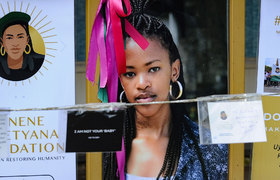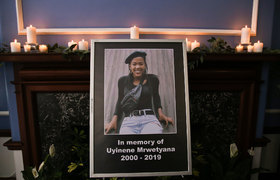Marching for memory, justice and change
26 August 2025 | Story Myolisi Gophe. Photo Nasief Manie. Voice Cwenga Koyana. Read time 6 min.
A new study by the Human Sciences Research Council shows that South Africa continues to face a persistent epidemic of gender-based violence (GBV), despite years of effort to address it. But the annual Uyinene Mrwetyana Memorial March is proving to have a profound positive impact on the ground, particularly in shifting attitudes among men and young boys.
On Saturday, Staff and students from the University of Cape Town (UCT) and other institutions; pupils, staff, and members of the public braved cold and rainy weather to take part in the anti-gender-based violence and femicide (GBVF) walk. The march stretched from Darling Street, near the Cape Peninsula University of Technology, to Parliament.
This year’s theme, “Reimagining Safety: Developing the Boy Child as Catalysts for Change”, was chosen to highlight the role of nurturing, educating, and empowering boys as part of building a safer society for all. The march was organised by the Uyinene Mrwetyana Foundation (UMF), in partnership with UCT and organisations such as Langa For Men.
The event honoured the memory of 19-year-old Uyinene Mrwetyana, a UCT student who was raped and murdered by postal worker Luyanda Botha at the Clareinch Post Office in 2019, as well as all victims of GBVF. Popular artist Zolani Mahola moved the crowd with a powerful performance.
“Change is happening on the ground”
Leading the march were Uyinene’s mother, Noma Mrwetyana; UCT Deputy Vice-Chancellor for Transformation, Student Affairs and Social Responsiveness Professor Elelwani Ramugondo; and former Western Cape MEC for Health Dr Nomafrench Mbombo, among others.
Although the pain of Uyinene’s death remains, her mother said she has witnessed signs of change. A traffic officer told her that Uyinene’s story brought him closer to his daughter, who is at university.
“So, change is happening on the ground. We may not see it, but in the minds of men there is some change in how they view young girls and how they raise their children. There are many women who have been saved because of Uyinene’s passing. We are saying no other woman must go through what she went through.”
Addressing the marchers, Professor Ramugondo rooted her call to action in South Africa’s history and collective responsibility.
“You can’t live when you have harmed a woman because land is incubated within these very bodies. We’re not talking about physical death … you exist only in flesh, but you are gone. You are no longer a human being in the sense of ubuntu. When a woman’s body becomes a weapon of war in a country that is otherwise not at war, something is broken.”
“When a woman’s body becomes a weapon of war in a country that is otherwise not at war, something is broken.”
The struggle, she stressed, is ongoing and is rooted in South Africa’s painful history.
“The struggle against GBV does not start today. In 1810, one of our ancestors, in many ways the mother of this nation, Sarah Baartman, was taken away from this country … treated like an animal … her body parts dissected and kept. That is not us. We must refuse to mirror colonial legacies of brutality.
“We will march every year until there are zero cases of GBV. I am grateful that we have this partnership with UCT, with the Uyinene Mrwetyana Foundation, with a family that turns tragedy into a legacy. This is a partnership to protect.”
Inequality and harmful masculinity
Dr Mbombo noted that South Africa is one of the most violent countries in the world, with violence rooted in systemic inequality.
“Our history of apartheid left a legacy of trauma and systemic injustice, which continues today through poverty, unemployment, and social pressures. Men, in particular, often face these pressures, and harmful cultural expectations around masculinity sometimes drive them to express power and identity through violence.”
She warned that violence spares no one.
“In the case we are talking about, the person was at a university, on a government platform. That means no one is safe. That’s why we must continue these commemorative walks and ensure people are aware.”
“Enough is enough”
UCT Students’ Representative Council (SRC) president, Thando Lukhele, called for urgent, collective responsibility in tackling GBV.
“We are not here to be quiet … we are here to amplify that this is a problem in our society and to be as loud as we can about it and say enough is enough in all its manifestations.”
She stressed that the struggle cannot be confined to universities.
“We can’t centre it around campuses only, because students and staff change. For lasting impact, we must extend awareness to communities. Having high schoolers here helps ensure that knowledge and action go beyond universities.”
“We must keep fighting the good fight and hold government accountable.”
Closing the event, Uyinene’s elder brother, Esona Mrwetyana, thanked participants for their solidarity.
“Your support makes the foundation’s work purposeful, meaningful, and impactful. Causes like this remind us that it is our duty as a society to stand up for what we believe in. Sadly, for us, it comes out of the passing of my sister. Sometimes it takes personal loss for us to act. This walk is symbolic because we march to Parliament, urging the government to act with us.
“Beyond raising awareness, we see the conversations happening on social media, in the news, and within our communities. Yet violence continues as though it is the new normal. That is why we cannot stop. We must keep fighting the good fight and hold government accountable.”
 This work is licensed under a Creative Commons Attribution-NoDerivatives 4.0 International License.
This work is licensed under a Creative Commons Attribution-NoDerivatives 4.0 International License.
Please view the republishing articles page for more information.




















